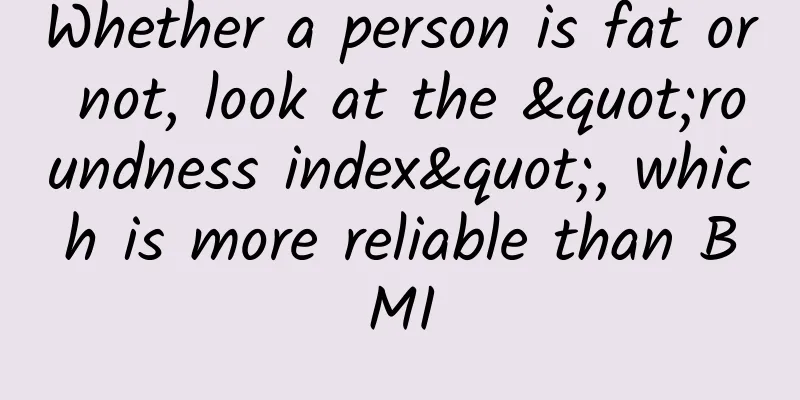Whether a person is fat or not, look at the "roundness index", which is more reliable than BMI

|
People who care about their health have generally heard of the BMI index. Many people will use the BMI index to test whether their current weight is overweight. However, this BMI index is not very accurate and may mislead you to eat more and gain more body fat . Today we will share another index. Referring to this index may make your body healthier! The classic BMI index may not work The BMI index (body mass index) is what we often call the body mass index. It is calculated by dividing the weight (kg) by the square of the height (m). Because it is easy to understand and convenient to operate, it has become the most commonly used indicator to assess whether one's current weight is normal. It is also an important indicator for large-sample screening of obesity in the population. BMI index classification standard However, because it relies on height and weight, it does not take into account the impact of different body compositions of the people being measured, resulting in BMI results that are inconsistent with the facts. In other words, two people with the same BMI index may have huge differences in health status . For example, for bodybuilders, their body fat percentage is very low and their muscle content is very high, but the weight of muscle is greater than the weight of fat. This will cause the BMI index of these bodybuilders to be high, and they can easily reach the level of overweight or even obesity, which goes against the original intention of the BMI index. There is another type of people who would be defined by the BMI index as having normal or even low weight. They look thin from a distance, but have an obvious big belly on their slender torso when viewed from the side. When their body composition is measured, the visceral fat is excessive. This type of people are the "thin high-fat group" and are the ones that cannot be measured by the BMI index. Copyrighted stock images, reprinting and use may involve copyright disputes Another limitation of the BMI index is that gender and age have a significant impact on it . Therefore, in the process of national physical fitness monitoring, in order to more accurately describe the weight health status of this age group, the BMI index classification standards will fluctuate according to gender and age. A better index to describe obesity: BRI index Since the BMI index is unreliable, are there other indicators that are both accurate and easy to calculate? There is indeed one, and that is the recently popular BRI index . The BRI (body roundness index) is called the body roundness index, which is used to assess whether the body's visceral fat content exceeds the standard. The index is calculated based on height and waist circumference. The higher the value, the more obvious the visceral fat accumulation, and the higher the incidence of diseases such as obesity and metabolic syndrome may be. BRI Index Calculation Formula Through this index, those " skinny fat people " can be screened out and given timely health management intervention. Compared with the BMI index, the biggest difference of the BRI index is that it does not take weight into account, but directly measures waist circumference, effectively screening those big muscle bodybuilders, and can also catch those with excessive visceral fat in time. Especially for the elderly, the BRI index can more accurately assess their health status . Excessive visceral fat is a major pain for the modern sedentary population. Excessive visceral fat increases the risk of chronic diseases such as coronary heart disease, type 2 diabetes, and metabolic diseases. People with excessive visceral fat are also called central obesity, which is characterized by a state of obesity that appears "normal" but is actually distributed in the abdominal viscera. The overall appearance is "normal", but the waist circumference increases. According to the population standard in China, if the waist circumference of men is ≥90cm and that of women is ≥85cm, it can be diagnosed as central obesity; or if the visceral fat area is ≥80cm², it can be diagnosed as central obesity by using CT or MRI and other equipment to accurately measure it. So, whether you are fat or not, it is more reliable to measure your waist circumference and calculate the BRI index . How to self-test the BRI index? Since waist circumference data is so important, waist circumference measurement should be as accurate as possible. The standard waist circumference measurement method is as follows: 1. The person being measured should wear light clothing, stand vertically, with feet naturally separated by 25 to 30 cm, weight evenly distributed on both legs, maintain steady breathing, and avoid measuring while inhaling. 2. Use a non-elastic tape measure with a minimum scale of 1mm to measure horizontally around the abdomen at the midpoint of the line between the highest point of the iliac crest and the lower edge of the 12th rib, keeping all parts of the tape measure in a horizontal position and close to the skin without compressing it. 3. During measurement, the person being measured should keep the abdomen relaxed and not contract it. 4. The measurement value should be accurate to 1mm. Currently, there is no unified standard for the normal range of BRI. Studies generally believe that people with a BRI of around 4.5 to 5.5 are relatively healthier and have a relatively lower risk of death . People with a BRI of less than 3.4 may have malnutrition, muscle atrophy or lack of activity, and their all-cause mortality rate may increase by 25%. People with a BRI of 6.9 or above may have a 49% increase in all-cause mortality, indicating more obvious visceral fat accumulation and a higher risk of cardiovascular disease, type 2 diabetes and other diseases. Limitations of BRI It should be noted that BRI also has certain limitations. As a newer physical assessment indicator, BRI has less research than BMI and is still in the accumulation stage . At present, there is a lack of sufficient long-term research data to support the specific changes and predictive value of BRI in different populations and different disease states. In addition, its measurement is relatively complicated. If the measuring position is slightly different, the measuring result will have a relatively large deviation. It is also not conducive to repeated measurement, so errors are prone to occur . In addition, body differences will also affect the evaluation of numerical results. For example, higher muscle mass may lead to higher weight and waist circumference values, thereby overestimating the BRI value and falsely indicating health risks. For example, for some fitness people with larger waist circumference, the BRI index will still be high (such as high-level weightlifters, etc.), but this does not mean that they have a higher risk of chronic diseases. References [1] General Administration of Sport of China. National Physical Fitness Monitoring Bulletin[R]. Website of General Administration of Sport of China, 2023-03-12. https://www.gov.cn/guoqing/2023-03/12/content_5745851.htm [2]Thomas DM, Bredlau C, Bosy-Westphal A, Mueller M, Shen W, Gallagher D, et al. Relationships between body roundness with body fat and visceral adipose tissue emerging from a new geometrical model. Obesity. 2013;21(11):2264–2271. doi: 10.1002/oby.20408. [3] Obesity Prevention and Control Branch of Chinese Nutrition Society, Clinical Nutrition Branch of Chinese Nutrition Society, Behavioral Health Branch of Chinese Preventive Medicine Association, Sports and Health Branch of Chinese Preventive Medicine Association. Expert consensus on obesity prevention and control among Chinese residents. Chinese Journal of Epidemiology, 2022, 43(5): 610-624 [4] Liu Weida, Liu Yuxia, Leng Zhiwei. Comparative study on the predictive value of different abdominal obesity indicators for cardiovascular disease in the elderly[J]. Practical Preventive Medicine, 2024, 31(10): 1168-1171+1199. [5]Zhang L, Yin J, Sun H, Dong W, Liu Z, Yang J, Liu Y. The relationship between body roundness index and depression: A cross-sectional study using data from the National Health and Nutrition Examination Survey (NHANES) 2011-2018.J Affect Disord. 2024 Sep 15;361:17-23. doi: 10.1016/j.jad.2024.05.153 [6] Fu Fanglin, Pan Yaojia, Han Zheng, et al. Correlation between body roundness index and abnormal body mass metabolism phenotype in elderly people of different genders: triglyceride glucose product index as a potential influencing factor[J]. Chinese General Practice, 2024, 27(30): 3746-3752+3757. [7]Qiu L, Xiao Z, Fan B, Li L, Sun G. Association of body roundness index with diabetes and prediabetes in US adults from NHANES 2007-2018: a cross-sectional study. Lipids Health Dis. 2024 Aug 17;23(1):252. doi: 10.1186/s12944-024-02238-2 [8] Han Zheng, Wang Weiqiang, Pan Yaojia, et al. Relationship between continuous metabolic syndrome scores and other obesity indicators and cardiometabolic comorbidities in people over 35 years old: a cross-sectional study in Anhui Province[J]. Chinese General Practice, 2024, 27(27): 3344-3350+3358. Planning and production Author: Yang Yizhuo, lecturer at the Sports and Medical Integration Innovation Center of Capital Institute of Physical Education Zhao Qian Rehabilitation Medicine Clinic Specialist Rehabilitation Therapist Reviewer: Tang Qin, Director of the Science Popularization Department of the Chinese Medical Association, National Health Science Popularization Expert Planning丨He Tong Editor: He Tong Proofread by Xu Lailinlin |
>>: After grains and vegetables, can we also “ask for food from the forest”?
Recommend
What are numbers? How do our brains perceive numbers?
A philosophical question has gradually evolved in...
International Stomach Protection Day丨These "stomach care" rumors will ruin your stomach sooner or later, and many people have fallen for it!
The stomach is an important organ of the human bo...
Striving for strength at sea, building a "national treasure" - Wan Buyan, a "model of the times"
He not only loves to read martial arts novels, bu...
Subconscious Guidance Technique: Adjust a man to the way you like him
Introduction to the audio lecture on emotions betw...
Casual games are also powerful. From "Journey" and "LittleBigPlanet 3" to look at the Chinese version of PS4 casual games
Opening the game download interface of the Chines...
Can WeChat images directly extract text and translate it? WeChat Android version internal beta has these updates
The Android version of WeChat has been put into i...
The World Cup has changed: people are more enthusiastic about buying lottery tickets than watching the games
When the World Cup group stage was not over yet, t...
Another success in pig organ transplantation! The world's first pig kidney was successfully transplanted into a human
Written by: Zhu Hengheng Editor: Wang Xinkai Layo...
Lander and astronauts to act separately? See what else China's preliminary plan for manned lunar landing says
China has announced a preliminary plan for a mann...
Inventory of "black technology" in mobile phones: walking between creativity and gimmicks
Please forgive me for coming up with this topic s...
How does Baidu promotion hosting company perform keyword segmentation? What are the specific techniques?
I am in the Baidu promotion hosting business. Whe...
How to build a drainage fission channel from 0 to 1?
This article is compiled from the open course joi...
Operational tips: 5 ways to quickly increase community activity
I often hear people say that they joined a commun...
How to improve activity and retention? A brief analysis of the user growth system in financial apps!
The user growth system refers to modules or funct...









